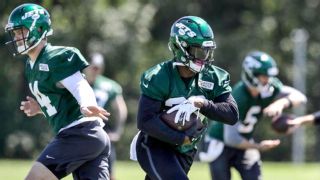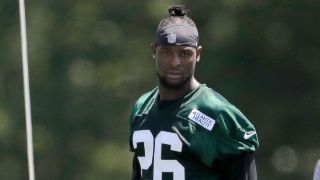|
FLORHAM PARK, N.J. -- Le'Veon Bell was mostly invisible in the offseason, skipping voluntary workouts, but he will be omnipresent once the season starts. He will be here, there and everywhere for the New York Jets: a running back. A slot receiver. A wide receiver. A workhorse. A decoy at times. A game-changer for the offense -- or so they hope. Jets coach Adam Gase has a chessboard in his mind, and he envisions Bell, 27, as the one player he can move anywhere on the board. How they integrate his unique skill set into the offense will be one of the season's most compelling storylines. Even though they had him in the spring for only two minicamp practices, the Jets are thinking big.  Let's take a closer look at the potential Le'Veon Bell effect, through the eyes of Gase, his assistants and other key players on offense: Let's take a closer look at the potential Le'Veon Bell effect, through the eyes of Gase, his assistants and other key players on offense:
Sam Darnold, quarterbackDarnold played his rookie season without a consistent threat in the backfield. In fact, the Jets had a 100-yard rusher in only two games (Isaiah Crowell both times). Not coincidentally, Darnold enjoyed two of his most efficient performances in those games. As a passer, he should benefit from Bell's ability as a receiver. Darnold's completion percentage when throwing to running backs -- tied for the league low at 68.0 -- should spike.
Darnold: "When he's out there in the huddle, the defensive coordinator doesn't know where he's going to line up. He doesn't know what's coming his way. With Le'Veon out there, we've become a little more unpredictable, just because he's such a great route runner. He's not just running a 'smoke,' and he's not just running 5-yard routes. He could run deep on you. He could run a slant ... and score. There are a lot of different things he can do." Bell's versatility will help Darnold make pre-snap reads, according to Gase. How? If they split Bell out as a receiver, it should be easier for Darnold to determine if the defense is playing man or zone. For instance: If the defense doesn't shift, it's zone. If a safety drops down to cover him, it's man. Gase believes Bell makes the Jets multidimensional. Gase: "Is he going to be in the gun? Strong? Offset? Weak? Is he going to be under center [in the Wildcat]? Is he going to be split out wide? Is he going to be the single receiver? Is he going to be in empty? Is he going to be in the slot? There are five different spots he can go if we go empty. "If you have a guy who can do all those different type of things and he's good at it, it makes it very difficult to defend. You start seeing coverages where they simplify it because you're moving so many pieces around. When you have that kind of flexibility, it puts a lot of pressure on the defense. It's hard to cover everything, so they simplify the defense. That's what helps the other guys, as well, because they're focused on [Bell] so much."
Robby Anderson and Quincy Enunwa, wide receiversBoth players were frustrated in their roles last season under former offensive coordinator Jeremy Bates. Enunwa felt he was pigeonholed as a screen receiver. In fact, he averaged only 7.3 air yards per target (AY/T), 60th out of 64 wide receivers with at least 60 targets, per NFL Next Gen Stats research. Anderson's issue was that he was used too much on deep balls. His AY/T was 16.5, which ranked second among wideouts. They both believe Bell's presence will add more balance and variety to the passing game. Enunwa: "It allows us to put us in different spots. It makes the defense guess. He can play outside, inside, in the backfield. It moves us into different spots as well. Everybody at the receiver position is able to play multiple spots. You can put a running back out there, or a tight end, and make it really hard on defenses." Anderson: "Sky's the limit. He can open things up for me and help us put points on the board and make more big plays. He's one of the best, if not the best at his position in the league. He's very versatile."  Kelechi Osemele, left guardBell's unique running style could be a challenge for Osemele and the rest of the offensive line. If he doesn't see immediate daylight, Bell will stay behind the line of scrimmage, waiting for a crease. In 2017, his final season with the Pittsburgh Steelers, he averaged 3.09 seconds behind the line per carry, longest in the league among running backs (minimum: 100 carries). Osemele: "He'll dance a little bit and then just tear through a hole. ... It'll be unexpected at first, until we feel it out and get used to him. I think we'll do some damage when we get that going. ... We'll know more when we get the pads on and get some reps, but players that are like that, that are patient, obviously, you have to stay on your block and you have to stay engaged. We'll see if he's the type of runner who will tap your hip as he's going by or what he does. That will come as we get used to each other."
Frank Pollack, offensive line coachIn Pittsburgh, Bell didn't have to deal with a lot of eight-man fronts because of the talent on the perimeter. In 2017, he faced an eight-man box on only 19.9% of his carries, 20th among 26 running backs with at least 100 attempts. In case you haven't noticed, the Jets don't have wideout Antonio Brown, which means opponents can overplay Bell and crowd the line of scrimmage. Pollack: "As a line coach, I don't think I'd be doing my job if I didn't anticipate eight- and nine-man boxes. I'm used to that everywhere I've been in the league. I mean, he's a talented back. They're going to load the box to stop him. If they do or they don't, you have to execute up front. In this league, it shouldn't have any bearing what we do up front and what we teach. You just need schemes to account for that. I take it as a compliment if they load the box." Adam Gase, playcallerIn 2017, Bell lined up in the backfield on 783 snaps (88%). He lined up as a slot receiver for only 63 plays (7%) and as a wide receiver for just 44 plays (5%). The majority of his receptions (68 out of 85) came out of the backfield, many of them on checkdowns with his back to the defense. Look for Gase to add more variety to Bell's game. Gase: "I'm going to really lean on what he does well. I can watch as much film as possible from Pittsburgh and say, 'This is what he's done; this can be my starting point.' That is kind of our starting point. Really, it's going to be the communication, him saying, 'I've never tried this before, can I try this? Can I do these routes?' ... For me, to get used to what he likes, it's communication, that constant communication in person that helps a playcaller."
Kelvin Beachum, left tackleBeachum knows Bell better than anyone on offense because they were teammates with the Steelers from 2013 to 2015. Beachum said his appreciation for Bell goes beyond blocking schemes and formation versatility. It's about a mindset. Beachum: "He makes people tap out. He makes the defense tap out. I can allude to a number of games where he literally wore the defense out. We kept running the same play over and over and over. They knew it was coming, we knew it was coming and he made somebody miss and he just wore the defense out."
|
